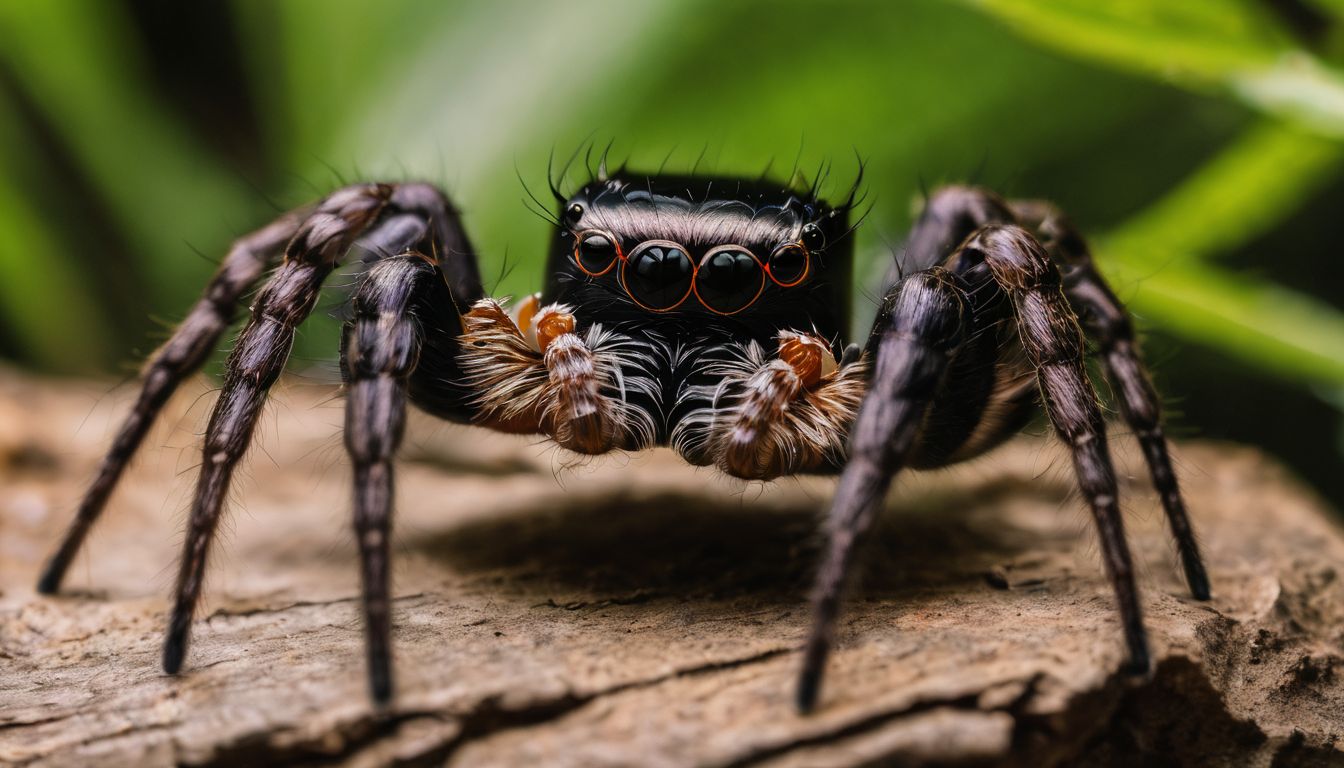Are you noticing more spiders around your home lately? Joro spiders, an invasive species known for their large webs, might be the culprits. This guide will share effective methods to remove these pesky arachnids and reclaim your space.
Keep reading to become a Joro spider-free household!
Key Takeaways
- Joro spiders are invasive arachnids known for their large, colorful bodies and prominent wheel-shaped webs.
- Effective methods for controlling Joro spiders include manual removal techniques, setting traps for capture, using insecticides and natural repellents, as well as employing natural remedies such as garlic and vinegar solutions and planting spider-repellent flora.
- Identifying signs of a Joro spider infestation early is crucial to implementing control measures before their population becomes extensive.
Identifying a Joro Spider Infestation

Joro spiders are large, colorful arachnids with distinctive wheel-shaped webs. Signs of an infestation include the presence of egg sacs and spiderlings in and around your home.
Appearance of Joro Spiders
Joro spiders are easy to spot because of their bright colors and big size. They have a shiny blue or yellow body with red marks on their belly. Their legs are striped with bands of black and yellow, which makes them stand out.
These spiders also make huge wheel-shaped webs that can catch your eye in the sunlight.
You might see these spiders hanging upside down in their strong webs, waiting for bugs to come along. When they move to new places, they use a neat trick where they let out silk into the air and float away with the wind like tiny spider balloons!
Signs of an Infestation
Joro spiders can become a big problem if they move into your area. You might notice more and more of them because they spread easily, making big webs as they go.
- Look for colorful spiders: Joro spiders are easy to spot with their bright yellow and blue colors on their bodies.
- See big, orb-shaped webs: These spiders make large webs that look like a circle. They usually build them in trees, bushes, or on the side of buildings.
- Find many spiders in one place: If you see groups of Joro spiders hanging out together, that’s a sign there are too many of them around.
- Notice tiny spiders floating: Baby Joro spiders can fly using threads of silk—a trick called “ballooning.” If you see them up in the air, they might be spreading to new places.
- Spot egg sacs: The presence of white or yellowish balls that are actually spider egg cases means more Joro spiders will hatch soon.
Are Joro Spiders Dangerous?

Joro spiders are not a threat to people. Their venom is for catching bugs, not hurting humans. If they bite you, it feels like a bee sting but most Joro spiders don’t bite. They want to stay away from us just as much as we want to keep clear of them.
Now let’s look at some smart ways to control these eight-legged visitors.
Proven Methods for Controlling Joro Spiders
You can effectively control Joro Spiders through manual removal techniques and setting traps for capture. Additionally, using insecticides and natural repellents can help keep these invasive spiders at bay.
Manual Removal Techniques
To physically remove Joro spiders and their webs from your home or property, you can use the following manual removal techniques:
- Wrap the spiders up in their web using a tissue or paper towel, then carefully dispose of them in an outdoor trash can.
- Use a vacuum with a hose attachment to gently suck up the spiders and their webs. Empty the vacuum bag immediately into an outdoor trash bin.
Setting Traps for Capture
For those who prefer a hands-off approach, setting traps is another effective method for getting rid of Joro spiders. Here are some simple and proven ways to set traps and capture these invasive spiders:
- Sticky traps: Place sticky traps in areas where Joro spiders are commonly found, such as corners, along baseboards, or near windows and doors. The spiders will get stuck to the adhesive when they walk over the trap.
- DIY traps: Create your own traps using common household items like empty jars or containers. Place these traps in areas where you have seen the spiders, baited with items like fruit or insects.
- Commercial traps: Purchase commercially available spider traps that are designed specifically for capturing spiders. Follow the instructions on the packaging for optimal placement and usage.
- Regularly check traps: Inspect and replace traps regularly to ensure they remain effective in capturing Joro spiders.
- Dispose of captured spiders: Safely dispose of captured Joro spiders by carefully removing them from the trap and releasing them outside, away from your home.
- Monitor effectiveness: Continuously monitor the effectiveness of the traps and make adjustments as needed to maximize their capturing potential.
Similarities and Differences Between Joro Spiders and Jumping Spiders
While Joro spiders and jumping spiders may look similar at first glance, there are key differences in their behavior and physical characteristics. Understanding these differences can help in effectively identifying and controlling Joro spider infestations.
Keep reading to learn more about how to distinguish between the two species.
Applying Insecticides and Natural Repellents
To control Joro spiders, you can use insecticides and natural repellents. These methods are effective in eliminating and deterring these invasive spiders. Here are some simple ways to apply insecticides and natural repellents for managing Joro spiders:
- Use insecticides containing bifenthrin, deltamethrin, or lambda – cyhalothrin. These have been proven to effectively eliminate Joro spiders.
- Consider using natural repellents like Zevo Insect Killer Spray, which has shown over 97% mortality in testing against Joro spiders.
- When using insecticides, follow the instructions on the label carefully to ensure safe and effective application.
- Apply the natural repellents in areas where Joro spiders are commonly found, such as around windows, doors, and other entry points to your home.
- Remember to reapply the natural repellents according to the product’s directions for continued protection against Joro spiders.
- Consider using a combination of both insecticides and natural repellents for a comprehensive approach to controlling Joro spiders effectively.
- Regularly monitor treated areas to ensure that the insecticides and natural repellents are effectively managing the Joro spider population.
Natural Remedies to Deter Joro Spiders
Combat Joro spider infestations using natural remedies such as garlic and vinegar solutions, as well as planting spider-repellent flora in your home or garden. These environmentally friendly methods are effective in deterring Joro spiders without harming other beneficial insects.
Using Garlic and Vinegar Solutions
To deter Joro spiders, you can use garlic and vinegar solutions. Here’s how to use them effectively:
- Mash several cloves of garlic thoroughly.
- Mix the mashed garlic with vinegar to create a solution.
- Place the solution in a spray bottle for easy application.
- Spray the solution around areas where Joro spiders are likely to hide or build webs, such as windowsills, doorways, and other entry points.
- Reapply the solution regularly, especially after rain or when the scent diminishes.
Planting Spider-Repellent Flora
Continuing our exploration of natural remedies to deter Joro spiders, another effective method is planting spider-repellent flora. Here are some easy ways to do this:
- Consider planting marigolds, lavender, eucalyptus, or mint around your home and garden. These plants naturally repel spiders due to their strong scents.
- Create a barrier of spider – repellent plants around entry points like doors and windows to discourage Joro spiders from entering your living spaces.
- Additionally, maintaining a well – trimmed garden and removing excess vegetation can help reduce hiding spots for these invasive spiders.
- Regularly cultivating aromatic plants in your yard not only adds beauty but also serves as a natural deterrent for Joro spiders.
Conclusion
In conclusion, removing Joro spiders can be done using simple methods like squishing them with a shoe or broom. Pest control professionals can also help in locating and eliminating their webs.
It’s important to understand that killing Joro spiders may not be necessary, as they mainly cover outdoor areas with their webs. Considering the impact on native insects is important when dealing with invasive species like Joro spiders.
Using spider sprays or insecticides can also be effective in controlling their population while minimizing harm to other wildlife.
For additional tips on dealing with other arachnid pests, check out our guide on how to get rid of jumping spiders.
FAQs
1. What are Joro spiders and why should we get rid of them?
Joro spiders, known as Trichonephila clavata, are a type of web spider from Northeast Georgia that can harm local plants, bees, and food crops like vegetables.
2. Can I use regular pest control methods to remove Joro spiders?
Yes! You can use spider sprays with chemicals like prallethrin or lambda cyhalothrin to kill these pests and clean up their webs.
3. Are there natural ways to control Joro spiders?
Sure! You might try insecticidal soap or sprinkle cinnamon oil around your garden which can help stop these spiders without hurting pollinators like bees in your area.
4. Will getting rid of Joro spiders hurt my flowers or vegetable garden?
Nope! When you carefully choose the right pest control solutions, you can protect your pollinator gardens while still removing these unwanted spiders.
5. Is it important to know about the egg stage when dealing with Joro spider control?
Absolutely! Knowing how they lay eggs helps you catch them early before they grow big and make more webs on things like turfgrass and ornamentals.
6. Should I be scared of venomous bites if I’m trying to eliminate Joro Spiders?
Not really. Although some people think all big spiders are venomous, researchers at places like the University of Georgia know that the venom from a Joro spider isn’t strong enough to seriously harm humans.




